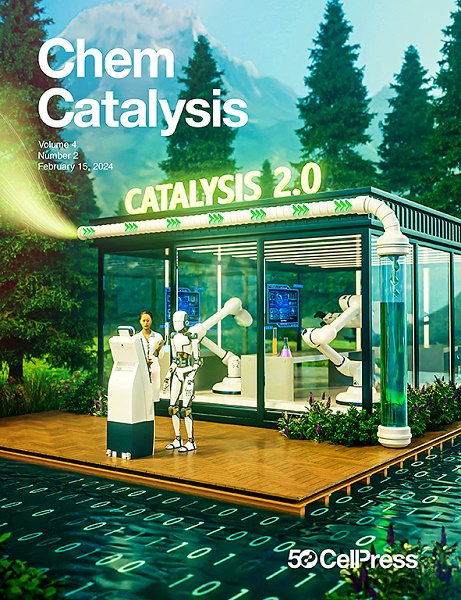Low-coordinated single-atom Cu and enhanced charge transfer from Cu-N to TiO2 on Cu1/CN/TiO2 for efficient Sonogashira cross-coupling
IF 11.5
Q1 CHEMISTRY, PHYSICAL
引用次数: 0
Abstract
This work presents a Cu single-atom catalyst (SAC)-catalyzed Sonogashira coupling reaction of lodine benzene and phenylacetylene to manufacture diphenylacetylene, with a satisfactory yield employing Cu single atoms on N-doped carbon (CN) supported on TiO2 (Cu1/CN/TiO2). Cu1/CN/TiO2 SACs with a low Cu loading (0.81 wt %) and a Cu-N2 structure achieved ultra-high conversion efficiency (99%) and yield for the Sonogashira coupling reaction, outperforming conventional heterogeneous and homogeneous Cu catalysts. Characterizations and density functional theory (DFT) calculations indicate that the presence of TiO2 not only alters the coordination environment of Cu to form the Cu-N2 coordination structure, with charge accumulation lowering the barrier for the adsorption and activation of the substrate, but also speeds the charge transfer from Cu1/CN to TiO2, which is advantageous for the oxidation addition steps in the reaction process, substantially boosting the Sonogashira coupling reaction. This work significantly broadens the scope of Cu SAC-catalyzed Sonogashira coupling processes.

Cu1/CN/TiO2上低配位单原子Cu和Cu- n向TiO2的电荷转移增强,实现高效Sonogashira交叉耦合
本文采用Cu单原子催化剂(SAC)催化氯苯与苯乙炔的Sonogashira偶联反应制备二苯乙炔,采用Cu单原子在负载在TiO2 (Cu1/CN/TiO2)上的n掺杂碳(CN)上制备二苯乙炔。Cu1/CN/TiO2 SACs具有低Cu负载(0.81 wt %)和Cu- n2结构,在Sonogashira偶联反应中具有超高的转化效率(99%)和产率,优于传统的多相和均相Cu催化剂。表征和密度泛函数理论(DFT)计算表明,TiO2的存在不仅改变了Cu的配位环境,形成Cu- n2配位结构,电荷积累降低了底物的吸附和活化障碍,而且加速了Cu1/CN向TiO2的电荷转移,有利于反应过程中的氧化加成步骤,大大促进了Sonogashira偶联反应。这项工作大大拓宽了Cu - sac催化Sonogashira偶联过程的范围。
本文章由计算机程序翻译,如有差异,请以英文原文为准。
求助全文
约1分钟内获得全文
求助全文
来源期刊
CiteScore
10.50
自引率
6.40%
发文量
0
期刊介绍:
Chem Catalysis is a monthly journal that publishes innovative research on fundamental and applied catalysis, providing a platform for researchers across chemistry, chemical engineering, and related fields. It serves as a premier resource for scientists and engineers in academia and industry, covering heterogeneous, homogeneous, and biocatalysis. Emphasizing transformative methods and technologies, the journal aims to advance understanding, introduce novel catalysts, and connect fundamental insights to real-world applications for societal benefit.

 求助内容:
求助内容: 应助结果提醒方式:
应助结果提醒方式:


